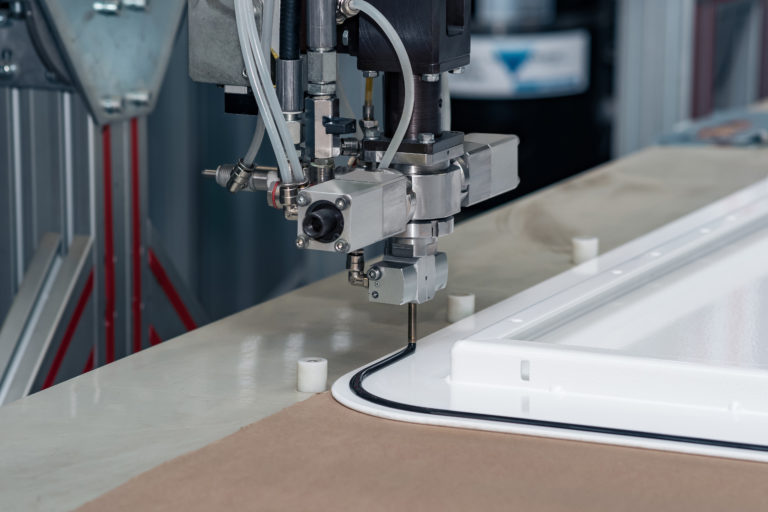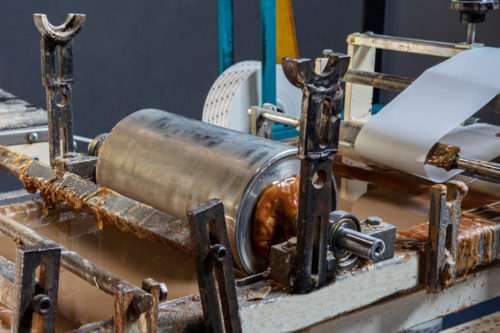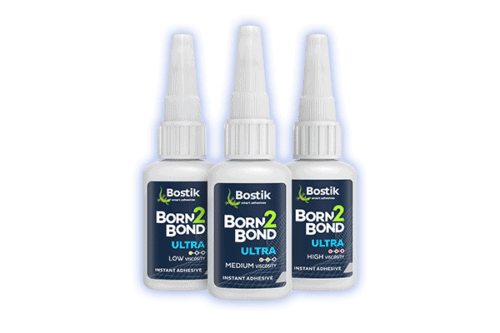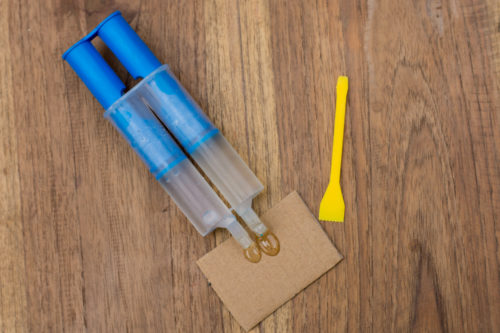Common Assembly Adhesives
The most common industrial adhesives are epoxies, polyurethanes, acrylics, and cyanoacrylates. These adhesives are widely used in various industries, including construction, automotive, aerospace, and electronics, as well as for bonding a wide range of materials, including metal, plastic, wood, rubber, polyurethane, and other synthetic materials. Each type of adhesive has its own unique properties and is suitable for different applications.

Adhesive Technologies That Stand Out
Hot Melt Adhesives

Hot melt adhesives are a type of adhesive that is applied in a heated, liquid state and then cools and solidifies to form a strong bond. They are commonly used in general assembly, woodworking, automotive, laminating, transportation and flooring. They are particularly useful in applications where a strong, flexible bond is required and where the adhesive needs to set quickly. Hot melt adhesives are also commonly used in the production of disposable products, such as diapers and sanitary products.
Hot melt adhesives are known for their fast bonding speed and strength, ease of use, and versatility to bond a wide range of materials, including plastics, metals, woods, laminates, fiberglass, foam, azdel, and luan, which is particularly important in high-speed production environments.
They can be applied using various methods, including extrusion, spraying, or roll coating, and they are available in a range of viscosities, hardnesses, and formulations to suit different applications.
Pros
- Hot melt adhesives have fast bonding speed.
- Making them ideal for applications where speed is a priority, such as manufacturing or assembly operations.
- Hot melt adhesives are applied in a liquid state, making them easy to spread or sprayed onto a surface using specialized equipment.
- Making hot melt adhesives ideal for applications where a large amount of adhesive needs to be applied quickly and evenly.
- Hot melt adhesives are water-resistant, flexible, and durable.
- Some hot melt adhesives are resistant to many chemicals and can be used in a wide range of temperatures
- Making them suitable for use in a variety of environments.
Cons
- Hot melt adhesives require heat to activate.
- Hot melt adhesives cannot be used in applications where the materials being joined can’t be exposed to high temperatures.
- Hot melt adhesives are not as strong as some other types of adhesives, such as epoxy or cyanoacrylate adhesives.

Cyanoacrylate

Cyanoacrylate adhesives are known for their ability to quickly create strong bonds, making them a popular choice for many applications.
In industrial settings, it is often used as a bonding agent for materials that need to be joined together quickly and securely. This can include a wide variety of applications, such as sealing or attaching components in the automotive and industrial industries or bonding metal, plastic, and wood in the construction and woodworking industries.
Pros
- Cyanoacrylates have the ability to bond quickly and strongly.
- Cyanoacrylates are easy to apply.
- Making it a convenient and efficient option for many types of projects.
Cons
- Cyanoacrylates do not have a very high-temperature tolerance
- It may not be suitable for applications where the bonded materials will be exposed to extreme heat.
- Cyanoacrylate can be challenging to remove once applied
- It is essential to be careful and precise when using it.
- Cyanoacrylates are not a very versatile adhesive, as it is unsuitable for bonding certain materials, such as polyethylene or polypropylene
- Unless using a specialized cyanoacrylate such as Born2Bond.

Epoxy

Epoxies are a type of polymer made up of long chains of molecules that bond together to form a very strong and resilient material. Epoxies are often considered structural adhesives due to their strength and resilience.
Epoxies are used in many industrial applications because of their strong bonding properties and ability to withstand extreme temperatures and harsh environments. They are often used to bond materials together that would otherwise be difficult to join, such as metals, ceramics, and glass.
Additionally, epoxies are often used as protective coatings in the automotive, and construction industries, where they provide additional strength and durability to structures. They are also used in electrical and electronic applications as insulators to protect against electrical shock.
Pros
- Epoxy adhesives have strong bonding power and versatility to bond to various materials such as metal, glass, Teflon, and plastic.
- Epoxies are relatively easy to use and can be applied quickly and efficiently.
- Epoxies are resistant to many chemicals and can withstand high temperatures.
Cons
- Epoxy adhesives are they are not always as flexible as other types of adhesives.
- Epoxies can be brittle, making them susceptible to cracking or breaking under stress.
- Making them less suitable for applications with a high degree of flexibility.
- Epoxy adhesives also require a longer curing time than other adhesives
- Which can be inconvenient if you need to make a quick repair.

How to choose the right adhesive for the job?
There are a few factors to consider when choosing the right adhesive for a project.
- The first thing to consider is the type of materials you will be bonding. Different adhesives work better with certain materials, so choosing an adhesive that is designed for the materials you’re working with is essential.
- Another important factor is the strength of the adhesive. Different adhesives have different levels of strength, so choosing an adhesive that is strong enough to hold your materials together is essential.
- Drying time. Some adhesives dry quickly, while others take longer to dry. This can be important depending on the project you’re working on. For example, if you need the adhesive to dry quickly so you can move on to the next step of your project, you’ll want to choose a fast-drying adhesive.
- Overall cost. Adhesives can vary in price, so choosing an adhesive within your budget is important. Keep in mind that in many cases, it’s worth it to spend a little extra on a high-quality adhesive to ensure that your project will be successful.
- The best way to choose the right adhesive for a project is to review the project with one of our industry experts.
The best way to choose the right adhesive for a project is to consider the specific materials you’re working with, the strength and drying time you need, and your budget. You can also consult with one of our specialists for advice on which adhesive to choose.
Contact Us
Please fill out the form below, and we will reply within 1 business day.